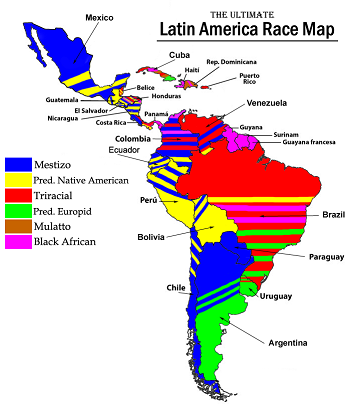6.3 Population and Demographics
4 min read•june 18, 2024
B
Brittany Schwikert
AP Spanish Language 🇪🇸
54 resourcesSee Units
Through globalization, the world has become increasingly more interconnected and diverse. With that process comes demographic changes across the globe! In this guide we will explore the demographic changes that have occurred through historical processes. The advacements of science and technology also played a major role, through the development of easy and efficient transporation, for people to traverse the world. ✈
Population and Demographics
As many as 20 countries use Spanish as their official language, contributing to a total of 450 million native speakers of Spanish in the world. Spanish has become the second most spoken language in the world, right behind Chinese. Yet there are also many secondary and tertiary languages in Spanish speaking countries, due to indigenous roots and geographical boundaries. In this section, we’ll dive deeper into understanding how the early onset of Europeans has blended with indigenous civilizations, and created some of the most diverse populations in the world.
Population 👶🧒👦👧👨👩👴👵
As of 2019, Mexico is the country with the largest amount of native Spanish speakers in the world, with almost 122 million speaking Spanish as their first language. The second highest number of native Spanish speakers is Colombia with 49 million, then Argentina with 44 million, and in fourth, Argentina with nearly 43 million.
Countries with the largest number of native Spanish speakers worldwide as of 2019 (in millions)
🇲🇽Mexico | 121.9 |
🇨🇴Colombia | 49.44 |
🇦🇷Argentina | 44.08 |
🇪🇸Spain | 42.92 |
🇻🇪Venezuela | 31.35 |
🇵🇪Peru | 28.14 |
🇨🇱Chile | 18.32 |
🇪🇨Ecuador | 15.23 |
🇬🇹Guatemala | 13.42 |
🇨🇺Cuba | 11.39 |
🇩🇴Dominican Republic | 10.11 |
🇧🇴Bolivia | 9.52 |
🇭🇳Honduras | 9.04 |
🇸🇻El Salvador | 6.38 |
🇳🇮Nicaragua | 6.16 |
🇨🇷Costa Rica | 5.02 |
🇵🇾Paraguay | 4.88 |
🇵🇦Panama | 3.88 |
🇺🇾Uruguay | 3.43 |
🇵🇷Puerto Rico | 3.16 |
🇬🇶Equatorial Guinea | 0.9 |
Race 🧑🏽🧑🏻🧑🏿🧑🏼🧑🏾
The original inhabitants of Latin America hail from a diverse range of ancestries, races, and ethnic groups, thereby explaining why you may see every shade of skin tone while traveling from the tip of Mexico all the way to Argentina. Each country is unique given its origins and history. Some countries still have a dominant European ancestry, while others are known to have a dominant Mestizo population. Additionally, many Spanish speaking countries have large African or Amerindian populations.

Ethnic Groups
The countries that compose Latin America are some of the most diverse in the world, including roots from Native, European, African, and Asian cultures. Within these countries, there are seven ethnic groups.
Amerindians
Also known as Native Americans, Amerindians are the indigenous populations throughout Latin America that arrived before 8000 B.C.. Due to colonization, Amerindians suffered an immense population decrease, but have since recovered in some countries, such as Bolivia and Guatemala. Despite their dominance in pre-Columbian times, Amerindians now serve as a minority in most countries.
Whites
When Spanish and Portuguese settlers began exploring Latin America at the start of the 15th century, they brought over their languages, the Catholic faith, and many Iberian traditions. These Iberian settlers (Iberia was the name of the peninsula that now encompasses present-day Spain and Portugal) forever altered the DNA of Latin America, and now whites account for the largest ethnic group in Latin America.
Mestizos
Mestizos make up the majority of the population in half of the countries in Latin America. Their name comes from the Spanish word of “mixed race” and accounts for the intermixing between Europeans (whites) and Amerindians (indigenous).
Mulattoes
Mulattoes are people of mixed African and European ancestry. The most common pairing is Portuguese and Spanish ancestry mixed with those of enslaved African ancestry. Brazil has the biggest Mulatto population, but there is also a strong presence in the Caribbean, specifically in the Dominican Republic and Cuba.
Blacks
At the beginning of the 16th century, millions of Blacks, or those of African descent, were brought to Latin America as part of the slave trade. Similar to American enslaved people, the enslaved in Latin America were violently uprooted from their homes and brought against their will. However, those brought to Latin America were eventually able to buy their freedom. Black culture has had an immense impact through Latin America and has contributed greatly to music, dance, and the arts. Many Blacks in Latin America also identify as Afro-Latino given that they were born in Latin America and identify as Latino, but also identify culturally and racially as Black.
Asians
There are several million people of Asian descent living in Latin America, as well as descendants from the Philippines given it was previously a Spanish colony. Today, most Asians in Latin America are immigrants from both Japan and China. Small businesses founded by Asian immigrants have thrived in many communities across Latin America, leading to a good deal of population growth.
Zambos
Zambos are those of both African and Amerindian descent. This was often due to enslaved peoples escaping their community and finding refuge amongst the indigenous communities nearby. Zambos are a small minority in Latin America that primarily reside in Colombia, Nicaragua, Venezuela, and Brazil.

Ehnic Groups in Latin America, 2016
- Diversidad - refers to the variety or differences of something
- Hablantes nativos - native speakers of an official language of a nation/region
- Limites Geográficos - geographic boundaries, which help to determine the limits between nations and regions
- Raza - Race
- Etnia - Ethnicity
- Amerindios - Amerindians
- Ascendencia - ancenstry
- Linaje - lineage
- Refugio - Refuge
Browse Study Guides By Unit
👨👩👧Unit 1 – Families in Spanish-Speaking Countries
🗣Unit 2 – Language & Culture in Spanish-Speaking Countries
🎨Unit 3 – Beauty & Art in Spanish-Speaking Countries
🔬Unit 4 – Science & Technology in Spanish-Speaking Countries
🏠Unit 5 – Quality of Life in Spanish-Speaking Countries
💸Unit 6 – Challenges in Spanish-Speaking Countries
📚Study Tools
🤔Exam Skills

Fiveable
Resources
© 2025 Fiveable Inc. All rights reserved.